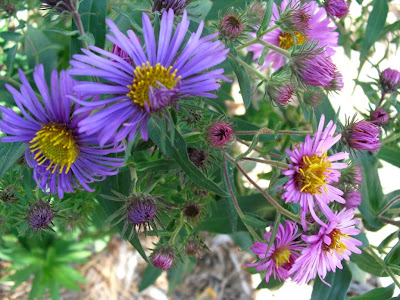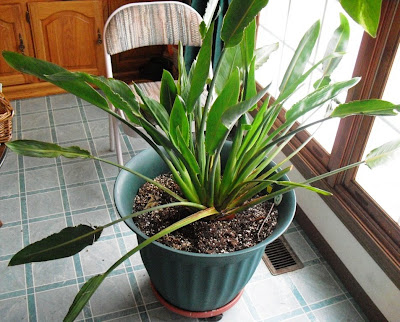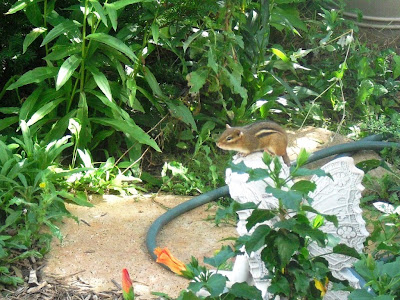As I've noted before, I don't put very many of my non-succulent houseplants outdoors. I try to choose plants that will do well indoors year-round, so I can always have a house full of plants. I might have mentioned this before, but one of the saddest things I've ever read on the Garden Web forums was a post by a woman who was lamenting that she had to bring her plants indoors in the fall. They had been doing so well outdoors over the summer, and she was dreading having to watch their inevitable, dramatic decline over the winter. But a major decline is
not inevitable if one chooses houseplants wisely in the first place. A plant that is happy with the available indoor conditions will not need to go outside, and if it does, will not decline drastically when brought back indoors.
That said, I do put a few houseplants outdoors in summer. A couple are just out there for decorative purposes, like my Norfolk Island Pine:
 Araucaria heterophylla dressing up my front porch
Araucaria heterophylla dressing up my front porchOthers I put outside because, I admit, they are exceptions to my rules. A couple aren't well-suited to my indoor conditions, despite my best intentions, and need a rejuvenating vacation outdoors. There are also a couple of plants, which despite being okay with their places inside, are "problem" or ailing plants. For those, a bit of natural rainfall, fresh air and summertime humidity will usually turn them around.
 Hedera helix, Fatsia japonica, and Dracaena reflexa 'Song of India.' The ivies and the Fatsia are outdoors because I think that fresh air and cooler night temperatures discourage spider mites. The Dracaena is just there because I like how it looks.
Hedera helix, Fatsia japonica, and Dracaena reflexa 'Song of India.' The ivies and the Fatsia are outdoors because I think that fresh air and cooler night temperatures discourage spider mites. The Dracaena is just there because I like how it looks.
 This Aspidistra elatior variegata was in the ailing plant category. I was perplexed by its failure to thrive, which I couldn't attribute to poor conditions or insects, so I put it under a tree and hoped for the best. It seems to be doing better.
This Aspidistra elatior variegata was in the ailing plant category. I was perplexed by its failure to thrive, which I couldn't attribute to poor conditions or insects, so I put it under a tree and hoped for the best. It seems to be doing better.
In one of my earliest blog posts, I recounted the tale of
"Foxy," my
Asparagus myersii (Foxtail Fern.) Well, Foxy also spent the summer outdoors, in the hopes that it will continue to bounce back after its major pruning last fall. Maybe someday, it will regain its former size and beauty, and I'll have to start the process all over again.

 Above, two pictures of Foxy, the Asparagus myersii.
Above, two pictures of Foxy, the Asparagus myersii.
 Another small Asparagus that I cut back, and is now rejuvenating itself
Another small Asparagus that I cut back, and is now rejuvenating itself Alpinia zerumbet variegata. I admit to abusing this poor plant this past winter, shoving it under lights in the basement, and frequently allowing it to get too dry. It has also recuperated nicely, and I've promised it a favored spot in a west window this winter, and plenty of water.
Alpinia zerumbet variegata. I admit to abusing this poor plant this past winter, shoving it under lights in the basement, and frequently allowing it to get too dry. It has also recuperated nicely, and I've promised it a favored spot in a west window this winter, and plenty of water.
 Tradescantia pallida, hanging around in my maple tree, just because. It was fine indoors, but I decided to put it out last month for its decorative value.
Tradescantia pallida, hanging around in my maple tree, just because. It was fine indoors, but I decided to put it out last month for its decorative value.
As autumn approaches, I will, of course, be bringing them back in. The
Asparagus, Fatsia and
Hedera helixes will stay out for quite some time yet, as they can handle a touch of frost. But when they do come in, I do not expect a dramatic decline from any of them.
 Blue and pink Asters. In person, the flowers on the right are a deeper shade of pink without the hint of purple seen in the photograph.
Blue and pink Asters. In person, the flowers on the right are a deeper shade of pink without the hint of purple seen in the photograph.





































